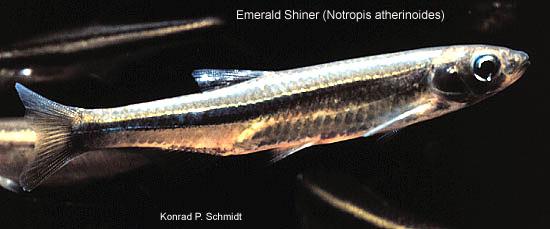Fish Iowa - Fish Species - Emerald shiner

Characteristics
The Emerald Shiner has an elliptical body shape and is slab-sided. They look fragile and delicate, but it is a hardy minnow. Their mouth is large, terminal, oblique, and has no barbel. The transparent dorsal fin has 8 rays, and it is behind the insertion of the pelvic fins. The anal fin has 10 to 12 rays, and the pectoral fins have 13 to 17 rays. Hooked pharyngeal teeth on strong arches are arranged in a 2, 4-4, 2 pattern. It has an emerald-green back, a distinct silver lateral band, and a white belly. A complete lateral line has 35 to 41 scales.
Foods
Terrestrial and aquatic insects at the surface
Expert Tip
- No results found
Details
The Emerald Shiner lives in a variety of habitats, as it is tolerant of a wide range of turbidities, bottom types, and current velocities. This shiner is characteristic of large, open channels of medium to large-sized, clear rivers and streams with sandy substrates, though it can enter the mouths of smaller streams. Large schools of Emerald Shiners are often found in the middle or uppers layers of water over firm bottoms; and noticeable current.
This cyprinid lives in the mid-depth to surface waters of the main channel and chutes in large streams, where they often are found in large schools. Spawning occurs from late May to mid-July. Adults may reach up to 3 l/2-inches long.
The Plains Shiner (Notropis percobromus) was recently incorporated into the Emerald Shiner species designation.
Recent stream sampling information is available from Iowa DNR's biological monitoring and assessment program.
Sources:
Harlan, J.R., E.B. Speaker, and J. Mayhew. 1987. Iowa fish and fishing. Iowa Conservation Commission, Des Moines, Iowa. 323pp.
Loan-Wilsey, A. K., C. L. Pierce, K. L. Kane, P. D. Brown and R. L. McNeely. 2005. The Iowa Aquatic Gap Analysis Project Final Report. Iowa Cooperative Fish and Wildlife Research Unit, Iowa State University, Ames.
Photo credit: Photo courtesy of Konrad P. Schmidt, copyright Konrad P. Schmidt
Distribution Map

Abundant in the larger interior streams throughout Iowa and in the Mississippi and Missouri Rivers. Widespread throughout the forested parts of northeast Iowa, but it is most prevalent in central and north-central Iowa, including the Boone, Raccoon and Des Moines Rivers. Populations of Emerald Shiners are rare in smaller streams. It has also been stocked into Rathbun Reservoir in the Chariton River watershed. The dramatic increase in the occurrence of the Emerald Shiner since the 1940’s is related to the reduction in turbidity created by reservoir construction.
See our most recent distribution data for this species on the Iowa DNR's Bionet application.
State Record(s)
No state record exists for this species
Submit your potential recordMaster Angler Catches
No Master Angler catches currently exist for this species.
Submit your Master Angler catchFish Surveys
Tip: Click Species Length by Site, then use the dropdown to filter by fish species of interest.Where this Fish Is Found
Bear Creek
Missouri River (Little Sioux to Council Bluffs)
Missouri River (Sioux City to Little Sioux)
Paint Creek
Pool 16, Mississippi River
Pool 17, Mississippi River
Pool 18, Mississippi River
Pool 19, Mississippi River
Spring Creek
Swiss Valley Creek
Upper Swiss Valley Creek